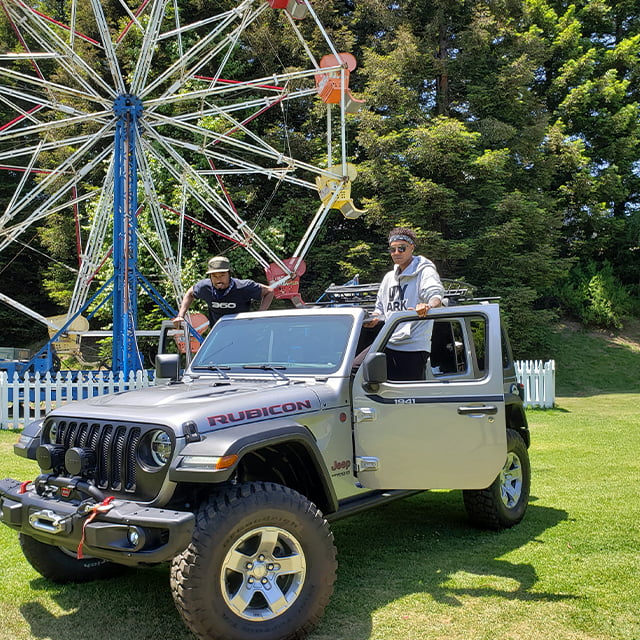Jeep and Ram brands both set full-year records in 2018 with sales up 17% and 7%, respectively. Both brands are poised to continue that momentum with the the return of a truck to Jeep’s lineup and the latest Ram HD that has once again set the benchmark for performance, capability, technology and luxury.
The 2019 Ram Heavy Duty is the most powerful, most capable pickup in the segment with a towing capacity of 35,100 lbs. and a payload capacity of 7,680 lbs. Driving it all, a never-before-seen torque rating of 1000 lb.-ft. from the Cummins I-6 Turbo Diesel engine. The new Ram Heavy Duty also sets benchmarks in ride and handling, luxury, materials, innovation and technology extending well past any competitive offerings. Giving maximum effort all day, every day with confidence, the new 2019 Ram Heavy Duty line of pickups steps forward with the full force of modern capability.
The all-new 2020 Jeep® Gladiator – the most capable midsize truck ever – builds on a rich heritage of tough, dependable Jeep trucks with an unmatched combination of rugged utility, authentic Jeep design, open-air freedom, clever functionality and versatility, best-in-class towing and 4×4 payload, advanced fuel-efficient powertrains, superior on- and off-road dynamics and a host of innovative safety and advanced technology features.
2.0-liter turbocharged inline four-cylinder engine
The all-new 2.0-liter turbocharged inline four-cylinder engine with eTorque technology is rated a best-in-class 270 horsepower and 295 lb.-ft. of torque and mated to a new eight-speed automatic transmission. The 2.0-liter turbocharged inline four-cylinder engine’s torque output surpasses that of the V-6 engine offered in Wrangler. An all-new eTorque system improves fuel economy, launch performance and driver comfort during start/stop operations.
The eTorque system’s hybrid functions include auto stop/start, electric power assist, extended fuel shut-off, transmission shift management, intelligent battery charging and regenerative braking. Both the engine and fuel flow may be turned off during stops, coasting or when the engine is decelerating.
The all-new 2.0-liter I-4 engine features a twin-scroll, low-inertia turbocharger with an electronically actuated waste gate for exceptional responsiveness and performance, even while traversing over difficult terrain. The turbo is mounted directly to the cylinder head to improve durability. A dedicated cooling circuit lowers the temperature of the intake air, throttle body and turbocharger.
The 2.0-liter turbocharged I-4 engine is part of the Global Medium Engine architecture family and features Double Over Head Camshafts (DOHC), dual independent camshaft timing and a cooled exhaust gas recirculation (C-EGR) system. This is the first time that the combined use of a twin-scroll turbocharger, C-EGR system, Central Direct Injection and the independent liquid cooling intake of air, throttle body and turbo have been employed together. This combination of technologies enables the high levels of performance and reduces fuel consumption.
Direct injection, coupled with turbocharging, enables more efficient combustion and increased performance. The 2.0-liter I-4 engine’s fuel pump supplies the engine’s 2,900-psi high-pressure common-rail injection system. These high pressures produce better fuel atomization and allow for more precise fuel delivery than port fuel-injected systems, which in turn improves both performance and efficiency.
A variable displacement two-stage oil pump provides high oil pressure under high speed and load, but switches to a low-pressure mode for improved fuel economy during typical driving conditions. The piston cooling jet operation is managed by the two-stage oil pump to enhance fuel economy under normal driving conditions while improving durability under demanding, high-load engine operation. A large capacity oil cooler extends the oil change interval and ensures engine durability.
The cast aluminum alloy cylinder head features a central injector and high tumble intake ports. This combination provides increased charge motion and balanced airflow for improved fuel efficiency and performance. Cast-aluminum pistons with a 10:1 compression ratio have four valve pockets to accommodate the dual Variable Valve Timing (VVT) system. Each cylinder bore is fitted with gallery-mounted piston oil squirters to limit piston temperatures, reduce spark knock and increase piston durability.
The 2.0-liter I-4 engine features a low-pressure, sand cast-aluminum block with cast-in iron liners. The bore diameter is 84 mm and the stroke is 90 mm. Total displacement is 1,995 cc.
A water-cooled, integrated exhaust manifold helps reduce turbo inlet temperatures while providing increased engine reliability.
An inverted tooth primary chain drives both the intake and exhaust camshafts and minimizes noise. Camshafts are robotically assembled using hollow shafts and have polished cam journals to reduce weight and improve durability for start-stop engine operation. The use of hollow shafts provides a 3.5 lbs. weight reduction when compared to an equivalent solid shaft.
Select-fit main and rod bearings enable reduced clearances to help lower system oil demand and oil pumping effort. In addition, floating piston pins utilize Diamond Like Coating (DLC) for reduced friction.
The ignition system includes a high-energy ignition coil for better fuel efficiency and precious-metal spark plugs with iridium and platinum provide lasting durability. Located in the center of the cam cover, the spark plugs are easily accessible when service is required. Sodium-filled exhaust valves and plasma-coated piston rings also help extend the engine’s life and bolster durability.






